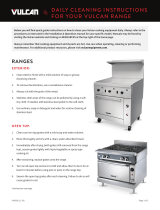
– 12 –
GAS CONNECTIONS
CAUTION: All gas supply connections and any pipe joint compound used must be resistant to
the action of propane gases.
Remove oven bottom(s) and baffles.
Remove upper manifold panel(s).
Connect gas supply to the range(s). Make sure the pipes are clean and free of obstructions, dirt and
piping compound.
Codes require that a gas shutoff valve be installed in the gas line ahead of the range(s).
Ranges manufactured for use with propane gas are equipped with fixed orifices.
WARNING: PRIOR TO LIGHTING, CHECK ALL JOINTS IN THE GAS SUPPLY LINE FOR
LEAKS. USE SOAP AND WATER SOLUTION. DO NOT USE AN OPEN FLAME.
After piping has been checked for leaks, all piping receiving gas should be fully purged to remove air.
Single Range Installations
All single stand-alone ranges require installation using a regulator (design-certified by a nationally
recognized testing lab to the applicable ANSI standard) for an outlet (manifold) pressure of 6" (1.49 kPa)
Water Column for natural gas supply, and outlet (manifold) pressure of 10" (2.49 kPa) Water Column
for propane gas supply (available from Vulcan-Hart). The regulator must be adjusted to agree with the
pressures indicated on the rating plate. When installing the regulator, follow instructions supplied by the
regulator manufacturer.
Manifold pressure for the incoming store line must be at least 7" (1.74 kPa) Water Column for natural
gas and 11" (2.74 kPa) Water Column for propane gas.
If a pressure regulator is not installed, the warranty on related parts, as well as performance-related
problems, will not be covered.
Battery Installations
The gas manifold of this range, or the battery of which it is a part, must be installed using a regulator
design-certified by a nationally recognized testing lab to the applicable ANSI standard (regulators
available from Vulcan-Hart). The pressure regulator must have a maximum regulation capacity to
handle the total connected load and must have an adjustment range for manifold pressure marked on
the range rating plate. If the manifold pressure of the connected ranges is not the same, a separate
regulator must be supplied for all ranges operating under different manifold pressure ratings.
If a pressure regulator is not installed, the warranty on related parts, as well as performance-related
problems, will not be covered.
TESTING THE GAS SUPPLY SYSTEM
When test pressures exceed
1
/2 psig (3.45 kPa), the range and its individual shutoff valve must be
disconnected from the gas supply piping system.
When test pressures are
1
/2 psig (3.45 kPa) or less, the range must be isolated from the gas supply
system by closing its individual manual shutoff valve.





















